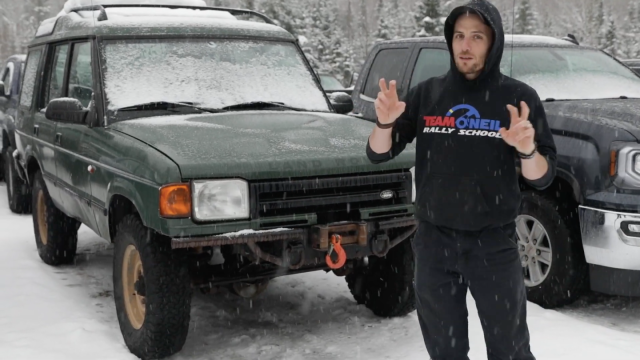With winter upon us, it would be wonderful if we had a trained rally driver with access to a bunch of all-wheel drive and four-wheel drive vehicles all assembled in one lot to helpfully explain the difference between these two ever-more confused terms. Oh wait, here he is!
This is Wyatt Knox of Team O’Neil Rally School. You may remember him from teaching my coworker and I how to take control of a car if your driver gets shot, and how to do a PIT manoeuvre, and, well, a lot of other things. Wyatt is a two-wheel-drive national rally champion, and knows his stuff. It is with this in mind that Wyatt explains why an older Subaru STI can be considered 4WD while even the coolest Ford Focus RS cannot, and where trucks and Land Rovers and Jeep Cherokees all fit into that.
Four-Wheel Drive: 100 per cent of the power is sent to the front and rear of the vehicle. That means you have a transfer case or locking center differential.
Part-Time 4WD: This means you can have the vehicle in 2WD or you can engage, usually, a transfer case to lock the front and rear together. Your front tires are turning at the same rate as your rear tires, which is what makes this good in the mud and snow, and what makes your dad yell at you to DON’T PUT IT IN 4WD ON THE ROAD you’ll chew up the tires.
What Are Some Vehicles: Jeep XJs, full-size trucks
Full-Time 4WD: This means all four-wheels are being driven, just not necessarily with front and rear locked together, though the car will let you lock everything together with a locking center differential. This is a differential in the middle of the car that locks the front and rear together so that everything spins at the same rate, giving you that 4WD. A Subaru STI with a locking center diff will, as Wyatt says, be 4WD if you look at it this way.
What Are Some Vehicles: Land Rover Discovery, boxy Audis from the 1980s, Subaru STIs with DCCD.
All-Wheel Drive: No transfer case, no locking center diff, either. Power can be sent to the front or rear, but it’s not locked together, so you’re not skittering around corners. Having this ability to keep things unlocked makes AWD cars driveable in normal situations.
Part-Time AWD: Power normally goes to either the front or rear of the car, but the car can send power to the other end, usually if it detects that the normal drive wheels are slipping. These are, like, front-wheel drive vehicles until the front wheels start spinning or, alternatively, rear-wheel drive vehicles until the rear wheels start spinning.
What Are Some Vehicles: Ford Focus RS, Mini All4s, VW Synchros
Full-Time AWD: Power is always going to all wheels, but it’s variable how much goes where. You have a center differential but it’s variable, like a viscous center diff or a clutch pack.
What Are Some Vehicles: Most Subarus
I am, of course, no expert, so just listen to Wyatt explain things and he’ll be clearer than I am.
The confusing part is that over the years, car companies have made big money selling all-wheel drive to increasingly scared Americans, and the number of terms about what’s on-demand and part-time and full-time have exploded. Moreover, just because you have 4WD doesn’t mean your vehicle is invincible in all conditions. Even if you’re locking the center of your car, if your front and rear differentials are open diffs that can’t lock, you can still end up spinning two lone wheels on a slippery surface.
As such, a lot of these arguments are kind of academic.
